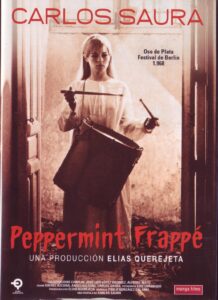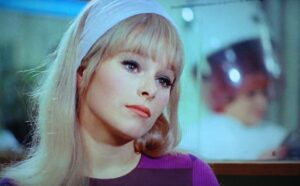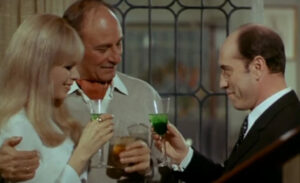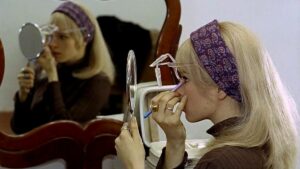“Peppermint Frappé” – Saura’s Drink with a Taste of Spain

Title: “Peppermint Frappé”
Release Date: 1967
Director: Carlos Saura
Cast: Alfredo Mayo, Jose Luis Lopez Vazquez, Gerladine Chaplin, Ana Maria Custidio
In “Peppermint Frappé”, Carlos Saura gives the audience a truly tasty cocktail. It blends the flavors of traditional Spain with a modern bouquet of spices that together create a whole that provides the viewer with a lot of sensual pleasure.
“Peppermint Frappé” is a film that, despite its age (it was made in 1967), has kept its freshness and still gives the viewer an authentic pleasure during the screening. In the foreground there is a fascinating story about a perfect crime. The main character of Carlos Saura’s film is a mature doctor, Juian (played by Jose Luis Lopez Vazquez), who lives in the Spanish provincial town of Cuenca. One day the man meets his childhood friend, Pablo (Alfredo Mayo), who has just returned to the country after many years abroad.
Nevertheless, Pablo has not come to his hometown alone, but with his beautiful young wife, Elena. The woman almost immediately becomes the object of Julian’s violent feelings. He tries to enchant her and persuade her to leave her husband. At the same time, Julian begins to meet with his young assistant, Ana, whom he persuades to completely change her image. The girl transforms from a gray mouse into an attractive sex bomb. When Elena finally rejects Julian’s love and reveals everything to her husband, the doctor lures the couple to his suburban mansion, drugs them with a substance poured into a drink (the peppermint frappé of the title), and then drives the car with the couple’s bodies off a cliff. Meanwhile, Ana, a mute witness to the whole event, transforms herself into a copy of Elena and takes her place in Julian’s life.

“Peppermint Frappé” – Pygmalion and Galatea
“Peppermint Frappé” is commonly read as a modern version of the myth of Pygmalion, a Cypriot king who fell in love with a woman he carved. Through the graciousness of Aphrodite, the object of the man’s affections was brought to life, and he was able to spend his life by his beloved’s side. The embodiment of Pygmalion in Saura’s film is Julian, who is unable to bestow feelings on a real woman – Ana. He prefers to indulge in his dreams about imaginary characters, which he cuts out from fashion magazines. In his mind, the attractive Elena, as a fair-haired foreigner (an ideal of a woman particularly glorified in Spain) is like a model taken out of a magazine.
Moreover, Julian’s ideal, like Pygmalion’s, is the quintessence of artificiality. He admires all the unnatural elements of a woman’s appearance: false eyelashes, wigs, and strong makeup. Julian is therefore undoubtedly a fetishist who enjoys dealing with women’s cosmetics, perfumes and make-up.
“Peppermint Frappé” – Spanish cult of femininity
Saura’s “Peppermint Frappé” extracts deep and ambivalent meanings from the Pygmalion myth, which become clear especially against the background of Spain’s patriarchal culture. The film exposes the contradictions inherent in the traditional social order, consisting in the idealization of women and their simultaneous discrimination. The phantasm of femininity becomes the sum of romantic notions (Elena), to which real femininity (Ana) in no way fits. Furthermore, the most important attribute of a woman is her appearance, which makes her act as a mere luxurious ornament of a man.

It is worth noting that Carlos Saura applied an interesting trick in “Peppermint Frappé”. He cast the same actress – Geraldine Chaplin – in two completely different roles of Elena and Ana. Interestingly, Luis Buñuel did the opposite a few years later in “The Obscure Object of Desire”. Saura’s idea is certainly ambiguous. It may constitute a metaphor for the internal contradiction of the cultural image of a woman. The dual role of Geraldine Chaplin may also suggest the duality of the female, but also of the general human nature. Ana would embody the dark side of her personality, full of complexes and fears, while Elena would embody a positive, bright and joyful attitude.
“Peppermint Frappé” – tradition versus modernity
Duality is not only a feature of the heroines of “Peppermint Frappé”, but also an attribute of the entire film space-time continuum. For we are dealing here with a clash between tradition, broadly conceived, and modernity. Childhood memories are thus confronted with adulthood, and customs originating in the past must confront the spirit of new times. The duality also extends to the spatial dimension – the provincial Cuenca with its symbolic rocky landscape is synonymous with old values, which are being overtaken by a breeze of changes in customs.
The mix is also repeated at the musical level of the film – typical Spanish compositions by Luis de Pablo and drum sounds from a local religious celebration are juxtaposed with the modern sounds of the rock band “The Keggs”. The clearest sign of the new is mass culture. Saura shows that, especially in the harsh Catholic provinces, where there is no alternative, pop culture is mistakenly identified with civilizational progress.

“Peppermint Frappé” – Cuenca, Calanda and Bunuel
“Peppermint Frappé” is also a film that captivates with truly painterly framing. The very choice of a magnificent, monumental space – Cuenca – is very successful in this respect. Cuenca, about which the Spanish director made his first film, is a city in the Castilla-La Mancha region. The old part of Cuenca, carved into the rock, is suspended over a precipice above two rivers.
The typically Spanish setting has added significance in Saura’s film. The mysterious, at times almost gloomy landscape contributes to the dark aura, becoming a projection of the psychopathic nature of the main character. Another Spanish town that appears as a leitmotif in the film, Calanda in Aragon, may have a similar meaning. It was there that Julian was to see for the first time Elena playing the drum passionately during the celebrations of Holy Week. It was then that the spark of obsessive love was born in the protagonist’s mind. What is more, by evoking Calanda Saura referred to his great master – Luis Buñuel, who came from this Spanish town. It is to him that the “Peppermint Frappé” is dedicated – a cocktail with a taste of Spain.
E. Królikowska, „Śladami Buñuela. Kino hispzańskie”, Warszawa 1988.

